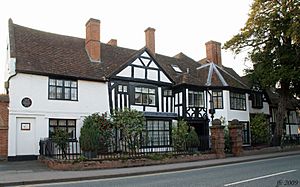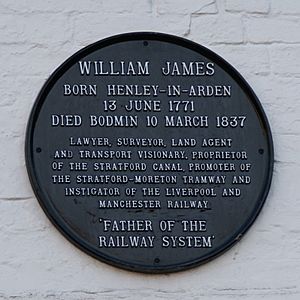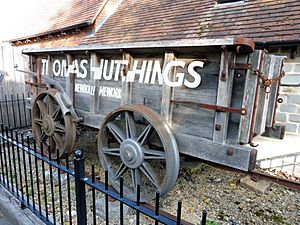William James (railway promoter) facts for kids
William James (born June 13, 1771 – died March 10, 1837) was an English lawyer and surveyor. He is known as a very early supporter of railways. Many people call him the "father of the railway system." He imagined and planned many railway lines when others thought it was a silly idea.
Contents
William James: Life and Work
Early Years and Education

William James was born in Henley-in-Arden, Warwickshire, in 1771. He was one of seven children. His father was a lawyer from Moseley, near Birmingham. William went to school at Warwick School and other places. He also studied law in London. After becoming a lawyer in Birmingham, he returned home around 1797. He worked in his father's law office.
In 1793, William married Dinah Tarleton. Her family owned land nearby. They lived in a house called Yew Trees in Henley-in-Arden. They were well-known and spent time with important families in the area.
Becoming a Land Agent
William's father was a rich man. But in 1797, the family faced money problems. So, in 1798, William James started a new job. He became a land agent. A land agent helps manage large pieces of land for wealthy owners.
He managed land for many important people. These included the Earl of Warwick and the Archbishop of Canterbury. William was good at understanding geology, which is the study of rocks and the Earth. He often told his clients to look for valuable minerals like coal on their land. This is how he first started thinking about railways. He even suggested an early railway line in 1802-1803.
Pioneering Railway Ideas
William James became very interested in railways around 1799. By 1806, he realized that the horse-drawn railways, used for centuries in coal mines, could be much more. He believed they could become a national system for public travel. Unlike others, he saw that railways could quickly move people, not just goods and minerals.
In 1808, James likely saw a steam engine called Catch me who can run in London. This made him think about how railways could grow in the future. He knew that stronger materials than cast iron were needed for the tracks. During the Napoleonic Wars in 1815, he even suggested a railway link. This link would connect two main naval shipyards. He thought it could carry passengers during peacetime.
In 1821, he visited coal mines in Northumberland. There, he met George Stephenson, a famous railway engineer. They made an agreement for James to sell Stephenson's new steam engines in southern England.
In 1822, James began surveying a route for the Liverpool and Manchester Railway. This was a very important project. He also surveyed routes for the Canterbury and Whitstable Railway in Kent. He believed in using steam engines for railways. However, Stephenson never built engines for James to show to potential buyers. So, James didn't make any sales through his agreement.
Facing Challenges
In 1822-1823, William James faced financial difficulties. He spent some time in prison because of debt. During this time, he still worked on plans for railways in southern England. Later in 1823, he was declared bankrupt.
These problems, along with working on too many projects at once, stopped him. He couldn't finish many of the railway plans he started. In 1824, George Stephenson took over the survey for the Liverpool and Manchester Railway. He mostly used the route James had planned. The next year, Stephenson also became the engineer for the Canterbury and Whitstable Railway. He used a route that James liked the least.
Canal Interests
Even though he saw the future in railways, James also had interests in inland waterways. He was part of the group that managed the Stratford-upon-Avon Canal. He helped finish it in 1816. He even suggested building a bridge for the canal out of cast iron to save money.
Later Life and Passing
In 1827, James moved to Bodmin in Cornwall. He worked to improve large estates there. He had plans to develop ports and build a railway from Fowey to Padstow. But none of these plans were completed under his management. After a difficult winter journey, he became very ill. William James died in Bodmin in early 1837.
Family Life
William James was a Freemason, a member of the Royal Society of Arts, and an officer in the military during the Napoleonic Wars. He married his first wife, Dinah Tarleton, in 1793. They had eight children together. After Dinah died in 1830, he married Elizabeth Butt in 1832. They had two more daughters. People said he was a bit heavy, but he had good manners. William James and his oldest son, William Henry James, also patented several inventions to improve transport.
Remembering William James


William James didn't get much credit for his work. George Stephenson, for example, never fully recognized his contributions. James tried to get financial help from Parliament, but it didn't happen. After his death, his children also tried, but their efforts were stopped.
One of James's daughters, Ellen Paine, wrote a book to defend her father. She felt he was not treated fairly in books about Stephenson. Today, William James is remembered with a plaque on a house in Henley-in-Arden. There is also a project to restore an old railway wagon from a line he helped plan. A road in Henley-in-Arden is also named William James Way.


